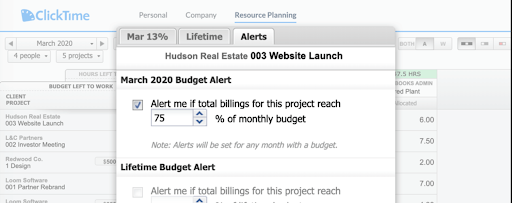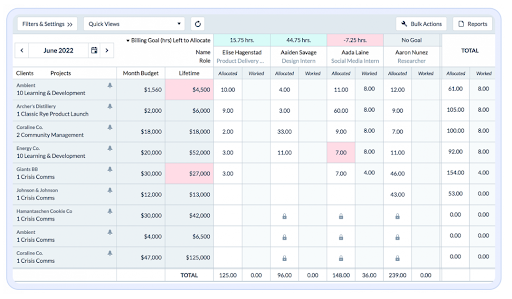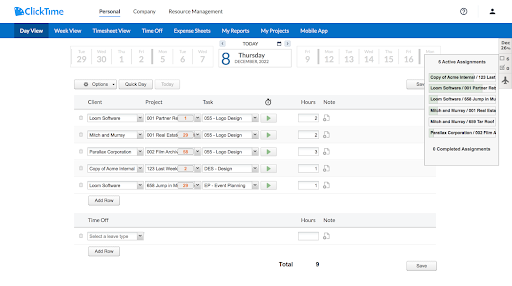What is a Resource Management Plan (And How to Make One)
Table of Contents
Whether you’re a nonprofit organization or a publicly traded company, maintaining profitability is an obvious key to success. But focusing on money often distracts leadership from effectively managing the most valuable resource in any company’s arsenal:
Time.
Every second that ticks by means more money flying out project budgets and less runway to reach milestones and goals. Whether it’s your employee’s time or that of a contractor, you must meticulously invest company time to balance profitability and project success.
This is where resource management plans come into the picture.
What is a Resource Management Plan?
Resource management is the practice of planning and assigning resources to maximize project efficiency and return on investment.
The resource management plan is a detailed account of the physical and intangible resources necessary to complete a project. It outlines how you will manage these resources throughout the project.
Resources can refer to anything the company uses to complete projects, from employees and contractors to equipment to digital tools. In service-based industries where companies are digitally-enabled—like consulting, software, and finance—resources mainly refer to a business’s workforce.
Resource management plans are a crucial component of the overall project management process, part of a larger framework for planning, managing, and analyzing service provision.
By creating this type of procedural framework, organizations set themselves up for project success in several ways, including:
- Optimizing the availability of resources
- Timing projects to reduce overscheduling
- Keeping key resources at or under capacity
- Identifying issues with utilization rates

Resource management platforms help you stay on top of utilization and servicing so projects don’t run over budget.
Now let’s look a little closer at the benefits of resource management planning.
Benefits of Resource Management Planning
The success of service-based businesses, major enterprise departments, and companies in heavily-regulated industries depends on the proper use of resources across projects. By developing an accurate resource management plan, companies can:
Eliminate Overservicing and Overutilization
Research shows that a significant percentage of service-based businesses and agencies overservice their clients — a number that jumps to a staggering 90% in niches like PR.
Using digital resource management planning tools, decision-makers not only create more accurate utilization projections, but they can intervene mid-project if overservicing eats into profit or overutilization starts to burnout employees.
Put the Right People on the Right Job
Even between multiple employees who perform the same role, they likely excel, or lack, in specific skills. Resource management planning allows you to quickly identify who among your talent pool is best suited to a specific project, so you can prioritize resources for your high-value clients.
Identify Potential Blockers
The resource planning process also allows you to forecast potential outcomes and identify any timeline conflicts or capacity constraints that might impact project outcomes and profitability.
Maximize Project Profitability
No matter what type of project timeline you’re on, resource management planning helps you to maximize profits by eliminating avoidable costs like overservicing or running over budget.
Gain Visibility into the State of Operations
Resource planning is essentially an informed prediction about allocating resources over a project’s scope. Comparing your projections with actual project outcomes gives you a wealth of data about the state of your operations.
Reduce Employee Burnout with Capacity Planning
Remember: your bottom line isn’t the only thing that suffers when resources are stretched thin. These “resources” are your coworkers, peers, and teammates — people susceptible to burnout when pushed past their capacity.
Resource planning protects your team (and budget) by identifying candidates with the bandwidth to take on additional work. This is achieved through capacity planning: a process where you map out how much work the company can take on, given the current workload across all employees.

Keeping track of employee utilization across projects helps identify issues with resource allocation and putting your staff over capacity
How to Develop a Resource Management Plan
Creating a resource management framework requires a thorough understanding of the project itself and the resources that you will leverage to complete it. Here’s how you can improve your company’s planning process:
1. Forecasting: Determine Resource Needs and Project Tasks
To accurately forecast resource needs for any project, you need to start with a solid grasp of the overall goal. Take stock of the desired outcome and relevant components by answering the following questions:
- What objective(s) are you looking to achieve?
- Which tasks must you accomplish to achieve the objective?
- What is the order for completing these tasks?
- What are the key deliverables of this project?
- What are the due dates for project tasks and final deliverables?
- What skill sets does this project require?
2. Allocation: Match Resources with Corresponding Tasks
Allocation is about finding the right match between the tasks you need to complete and the resources at your disposal. But it’s not just about identifying who is the best resource for the job, you need to consider variables like capacity constraints and current utilization rates.
Your ideal resource may be near capacity as you begin planning for a new project, meaning you need to identify alternative solutions. Resource management tools make tracking and updating resource allocation easy, so you can quickly identify the ideal candidate for your latest project.
Using a resource management tool, whether a spreadsheet or software platform, you can easily map out project timelines to see if there are any conflicts with the resources you’ve scheduled.
3. Communicate Time Allotment and Deadlines
As nice as it is to work at your own pace, that’s rarely the reality for service-based businesses. Time constraints exist so teams don’t get burnt out or eat into profits by overworking. Now that you’ve allotted time, it’s time to communicate those timelines to your team.
Communicating information about time allotment and deadlines helps get your team on the same page and gives employees a chance to voice concerns and questions about capacity.

Employees will know exactly where to spend their time each day with a view that shows their progress against assigned hours and how many assigned hours are left on the project.
4. Monitor Project Progress
As projects move from forecasting to management, you need to monitor how the project unfolds. If things are running smoothly, great! If not, you need to document what’s happened.
In either case, adopting tools that help you analyze and report on project progress is key to fine-tuning resource forecasting and service delivery for future projects.
5. Anticipate the Need to Adjust
If there’s one saying that project leads across finance, IT, and other departments need to remember, it’s this:
If you fail to prepare, prepare to fail. Contingencies are a vital part of any planning process, and you need to be prepared to immediately tackle issues caused by unexpected absences, delays, and other resource-related issues.
Reduce Unexpected Costs with Resource Management Software
Manual resource management planning can only take you so far, circumstances change at the drop of a hat, and you need more than just a rigorous planning process to achieve success.
Platforms like ClickTime provide your team with digital resource management tools for real-time tracking, data collection, and analysis of previous resource planning initiatives.




